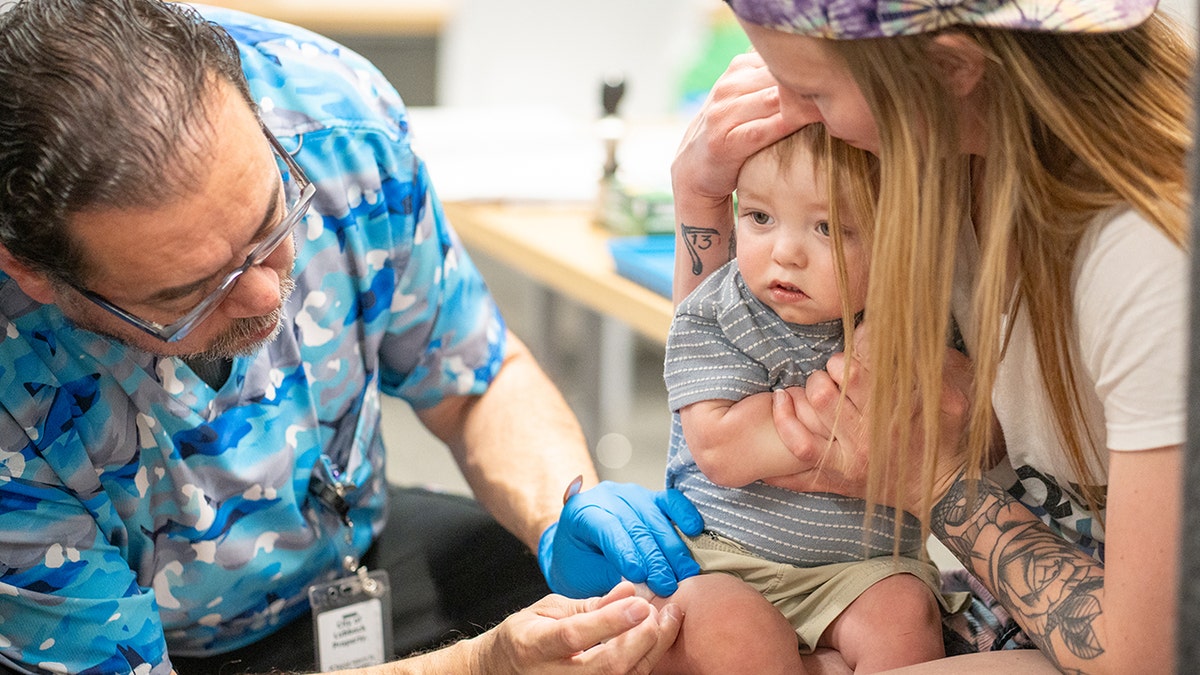Since ham cases are spreading throughout the United States-according to the all-CDC data, 12 states reports official outbreaks-concerns are raising concerns among high-risky groups.
Children under the age of 5 are the most vulnerable to ham, health experts confirm.
The CDC recommends that children take two doses of the MMR (Humps-Rubella) vaccine, starting with the first dose at 12 to 15 months, and the second dose at 4 to 6 years at the age of 4 to 6.
The outbreak of the ham across us is derived: see which states have reported cases
That means children under 5 may not have full protection of children.
Since ham cases are spreading throughout the United States-according to the all-CDC data, 12 states reports official outbreaks-concerns are raising concerns among high-risky groups. (Estock)
Alison Cruccher, DO, a pediatrician and a doctor in Osteopathic Medicine, with proper health and care in the Illinois, said that he often asked the question to protect their children from the most infectious virus from their parents.
Cruccher shared the most common searches he received with his response.
1 Should I be anxious about where I live or where I am traveling?
Ham cases have been reported in 20 states so far (according to CDC): Alaska, Arkansas, California, Colorado, Florida, Georgia, Hawaii, Illinois, Indiana, Kansas, Louisiana, Mishtiland, New York, New York, New York, New York, New York, New York, New York, New York, New Y New Pennsylvania, Road Island, Tennessee, Texas, Vermont, Virginia and Washington.

Children under the age of 5 are the most vulnerable to ham, health experts confirm. (Estock)
Even if you do not live in one of those fields, keep a deep eye on local health warnings, as the disease is evolving rapidly.
The Health Department website in your state, which should end on “.gov”, is a great place to start it. If you plan to travel to an area with the reports you have reported, be sure to ask for a guide from your doctor in advance.
2 How do I know if my child is fully vaccinated?
If they receive two doses of ham, mumps and rubella (MMR) vaccine in at least four weeks, a child is fully vaccinated for ham.
The first dose is usually given to the kids between 12 and 15 months, then the second is given in four to six years.

In the early stages, fever, cough, cold nose and red, boring eyes include symptoms. (Estock)
3 May my child get vaccine early?
In some cases, yes. Children who travel to regions with high-risky or active cases may be eligible to get MMR vaccine between the ages of six months to 12 months. It depends on individual situations, so it is important to talk to your pediatrician.
Keep in mind that an early dose does not count regular vaccination schedule – after your child’s first birthday, two additional doses will still be required.
Ham’s case with another state infected with an infected child confirms the first one of the year
4 What if my child is very young to get the MMR vaccine?
If your child is very young for the vaccine, it is important to have additional caution to restrict their exposure to others who may get sick. Don’t be afraid to travel or deny the gathering – you have every right to protect your child’s health.
5 … How early can my child get their second MMR vaccine?
For children over a year old, the second MMR dose can be given in the first four weeks. Once they both get the dose, the kids are fully vaccinated and no additional dose is needed.
“Due to the complexity of the disease, one to three in one thousand children suffering from ham will die.”
6 .. We’re around other people around the people recently traveled. What symptoms do we have to keep an eye on?
In the early stages, fever, cough, cold nose and red, boring eyes include symptoms.
These symptoms usually appear seven to 14 days after the initial exposure.
7. My child is showing a cold signs. Can it be in the early stages of ham?
This is not always easy to say, since the ham shares symptoms with many other illnesses. A key difference is that hamted children usually display very high favorites around 104 degrees Fahrenheit. They also be very worrying.
Click here to get Fox News app
Around the second or third day of the symptoms, many patients develop small, blue-white spots on their internal cheeks, which are known as the Coptic Spot-even if not every child will develop these spots. TeleTel red rash usually develops three to five days in illness.

If they receive two doses of ham, mumps and rubella (MMR) vaccine in at least four weeks, a child is fully vaccinated for ham. (Jan Sonenmayer/Getty Fig.)
8. What does the rash of the ham look like?
This rash usually begins three to five days after the initial symptoms. It starts as small spots on the face near the hairselle, then spreads downward and the whole body can cover the cover.
9. Why are ham dangerous?
Ham can have many complications, from light to severe. One in about 10 people will develop ear infections or diarrhea.
About one out of five people in the ham will need hospitalization. One of 20 people will deal with pneumonia, which is the most common cause of death from the disease.
Click here to sign up for our health newsletter
About one thousand children will develop encephalitis, or inflammation and brain swelling. It can cause itching, lifetime disability or even death. All in all, one to three thousand children infected with ham will die due to complications from diseases.
10. Why don’t some people get their kids MMR vaccine?
There is an increasing amount of misinformation and chaos that promoted vaccines, which have led to the delay or completely avoid them.
The MMR vaccine has been operated safely to several million people and has a great security record – and the research has repeatedly spread the story that the vaccine is associated with autism.
For further health articles, see www.foxnews.com/health
1. If I think my child can have a ham, what should I do?
Don’t wait – Contact your doctor now. They could guide you through the next step.
The above Q&A provided by the doctor of Osteopathic Medicine, with allison cursor, DO, a pediatrician and proper health and care in Illinois.
Leave a Reply